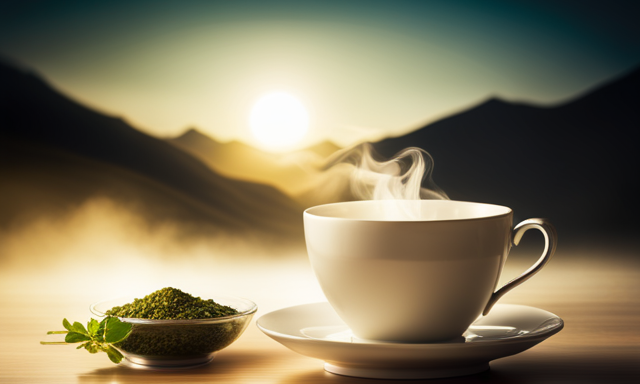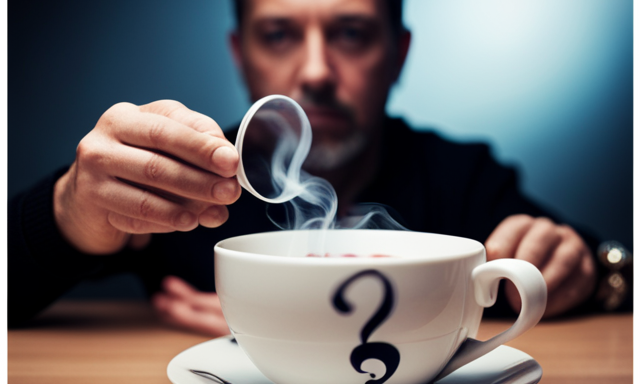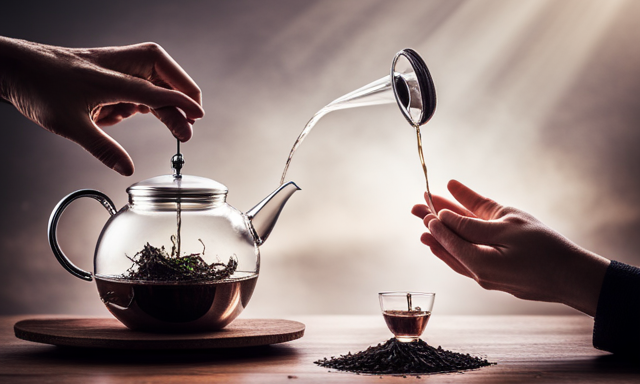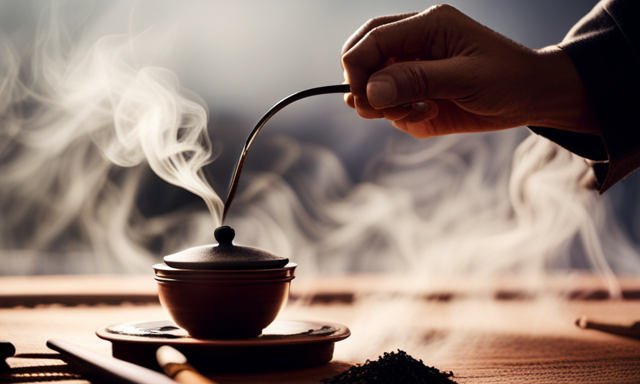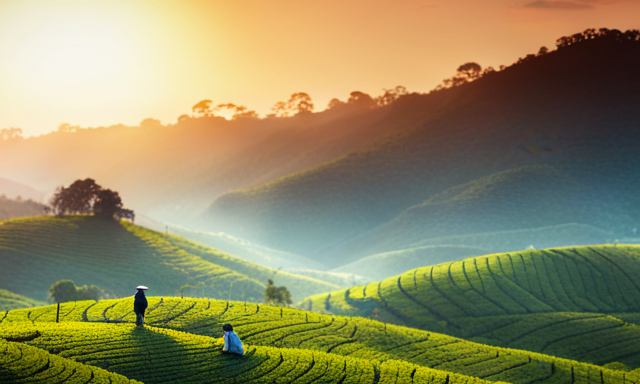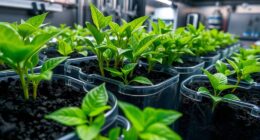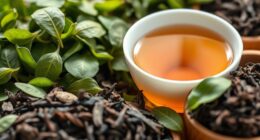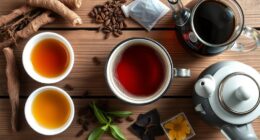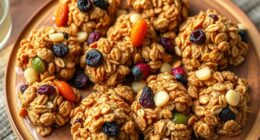Imagine waking up in the morning, craving a warm cup of tea to kickstart your day. As you stand in front of your tea collection, you’re faced with a decision: should you reach for the comforting green tea or the aromatic oolong tea? Both teas offer unique flavors and health benefits, but what about their caffeine content?
In this article, I will explore the question of how much caffeine is in green tea versus oolong tea. Using an objective and evidence-based approach, we will delve into the caffeine levels of each tea and discuss the potential health benefits and side effects. Additionally, we will explore the factors that can affect caffeine extraction during brewing.
By the end of this article, you will have the knowledge to make an informed choice and enjoy your cup of tea with confidence.
Key Takeaways
- Green tea and oolong tea both contain less caffeine than coffee.
- Brewing methods, such as steeping time and water temperature, impact caffeine extraction in tea.
- Oolong tea may have higher caffeine content due to longer steeping time and higher temperature.
- Opting for green tea can help limit caffeine intake and avoid jitters or sleep disturbances.
Understanding Caffeine Content in Tea
If you’re curious about how much caffeine is in your tea, you’ll be delighted to learn that green tea and oolong tea both pack a punch when it comes to their caffeine content! While herbal teas are known for being caffeine-free, green tea and oolong tea are exceptions to the rule.
When comparing the caffeine content in different tea types, it’s important to note that the brewing time and temperature can affect the final caffeine levels. On average, an 8-ounce cup of green tea contains about 25-29 milligrams of caffeine, while oolong tea contains slightly more at around 37-55 milligrams.
So, if you’re looking for a tea that provides a moderate caffeine boost, both green tea and oolong tea are great choices to consider.
Caffeine Levels in Green Tea
You may be surprised to learn that the caffeine content in green tea can vary depending on factors such as brewing time and temperature, with shorter steeping times resulting in lower caffeine levels. Understanding caffeine metabolism and the impact of caffeine on the body is important when considering the effects of green tea consumption.
Here is a table comparing the approximate caffeine levels in an 8-ounce cup of green tea brewed at different temperatures and times:
| Brewing Time (minutes) | Water Temperature (°C) | Caffeine Content (mg) |
|---|---|---|
| 1 | 70 | 25 |
| 3 | 80 | 35 |
| 5 | 90 | 45 |
It is worth noting that these values are approximate and can vary depending on the specific brand and type of green tea.
Moving on to oolong tea, it is interesting to explore the caffeine levels in this distinct tea variety.
Caffeine Levels in Oolong Tea
Exploring the caffeine content in oolong tea unveils yet another fascinating aspect of this unique beverage. Oolong tea contains varying amounts of caffeine, depending on factors such as the type of tea leaves used and the brewing method. On average, a cup of oolong tea contains about 37-55 milligrams of caffeine, which is less than the caffeine content in a cup of green tea but still more than what you’d find in most herbal teas.
The caffeine in oolong tea, like in green tea, is metabolized and absorbed by the body. The body’s metabolism and individual factors such as age, weight, and overall health can influence how quickly caffeine is processed and its effects. Understanding the caffeine levels in oolong tea provides valuable insights into its potential benefits.
Transitioning into the subsequent section about the health benefits of green tea, it becomes clear that both oolong and green tea offer unique advantages worth exploring further.
Health Benefits of Green Tea
When it comes to health benefits, green tea has a lot to offer. One of its key points is its antioxidant properties, which help to protect the body against free radicals and reduce the risk of chronic diseases.
Additionally, green tea has been shown to have potential weight management effects, as it can increase metabolism and help with fat oxidation.
Antioxidant Properties
Comparing the antioxidant properties of green tea and oolong tea, it’s clear that both varieties offer numerous health benefits.
Green tea is known for its high concentration of antioxidants, specifically polyphenols, which have been linked to a range of health benefits. These antioxidants help protect the body against free radicals, which can cause cell damage and contribute to aging. Additionally, green tea has been found to have anti-inflammatory properties, further contributing to its anti-aging effects.
On the other hand, oolong tea also contains antioxidants, although in slightly lower amounts compared to green tea. Despite this difference, oolong tea still provides some antioxidant benefits and may also have anti-aging effects.
Transitioning into the next section about weight management effects, it’s important to note that both green tea and oolong tea have been studied for their potential role in weight management.
Weight Management Effects
Both varieties of tea have shown promising effects on weight management, making them an excellent addition to a healthy lifestyle. Green tea and oolong tea have been found to assist in weight loss due to their ability to boost metabolism.
Here are three key reasons why these teas are beneficial for weight management:
-
Increased Fat Oxidation: Studies have shown that both green tea and oolong tea can enhance the body’s ability to oxidize fat, leading to greater weight loss.
-
Appetite Suppression: Drinking green tea or oolong tea can help reduce hunger and cravings, making it easier to stick to a calorie-controlled diet.
-
Thermogenic Effects: Both teas contain compounds that can increase thermogenesis, which is the process of generating heat in the body. This can further enhance calorie burning and aid in weight loss.
With their positive impact on weight management, it’s no wonder these teas are highly regarded.
Moving forward, let’s explore the specific health benefits of oolong tea.
Health Benefits of Oolong Tea
Oolong tea offers a multitude of health benefits that are sure to leave you feeling rejuvenated and energized. One of the key benefits of oolong tea is its antioxidant properties. Antioxidants help to neutralize free radicals in the body, protecting cells from damage and reducing the risk of chronic diseases like heart disease and cancer.
Additionally, oolong tea has been shown to boost metabolism, which can aid in weight management. Studies have found that oolong tea can increase fat oxidation and improve insulin sensitivity, helping to regulate blood sugar levels. These metabolic effects make oolong tea a great addition to a healthy lifestyle.
As we move into the next section about the side effects of caffeine, it’s important to note that oolong tea does contain caffeine, which can have its own set of potential drawbacks.
Side Effects of Caffeine
When it comes to the side effects of caffeine, two key points to consider are jitteriness and sleep disruptions. These can occur as a result of consuming too much caffeine, leading to restlessness and difficulty falling asleep.
Additionally, some individuals may experience sensitivity to caffeine. This can result in symptoms such as headaches, heart palpitations, and irritability. Others may even have allergic reactions.
It is important to be aware of these potential side effects and moderate caffeine intake accordingly.
Jitteriness and Sleep Disruptions
If you consume too much caffeine in green tea, you may experience jitteriness and have trouble falling asleep. Caffeine is a stimulant that can increase alertness and energy, but it can also disrupt sleep patterns and cause restlessness. Jitteriness is a common side effect of consuming excessive amounts of caffeine, and it can make you feel restless, anxious, and on edge. Additionally, caffeine can interfere with the quality of your sleep, making it harder to fall asleep and stay asleep throughout the night. To illustrate the potential impact of caffeine on sleep, consider the following table:
| Caffeine Consumption | Jitteriness Effects | Sleep Quality |
|---|---|---|
| High | Increased | Decreased |
| Moderate | Mild | Slightly |
| Low | None | Unaffected |
Understanding the potential effects of caffeine on jitteriness and sleep disruptions is important for managing your caffeine intake. Transitioning into the next section about sensitivity and allergic reactions, it is crucial to consider other potential adverse reactions to caffeine.
Sensitivity and Allergic Reactions
Be aware of your body’s sensitivity to certain substances, as allergic reactions to ingredients in tea can cause discomfort and potentially ruin your enjoyment of this calming beverage.
When it comes to caffeine consumption, individuals with sensitivity may experience adverse effects such as jitters, increased heart rate, and sleep disruptions. Green tea and oolong tea, although containing less caffeine than coffee, still have a considerable amount. Allergic reactions can also occur due to the caffeine intake in these teas.
It’s important to pay attention to any signs of allergic reactions such as hives, itching, swelling, or difficulty breathing. If you experience any of these symptoms, it’s recommended to consult a healthcare professional.
Understanding your body’s sensitivity and potential allergic reactions to caffeine can help you make informed choices when choosing the right tea for your needs.
Choosing the Right Tea for Your Needs
When it comes to choosing the right tea for my needs, I consider a few key points.
Firstly, I think about whether I want an energy boost or relaxation. For an energy boost, I might go for a tea with higher caffeine content like green tea. On the other hand, if I’m looking to unwind and relax, I might opt for a tea like chamomile or lavender.
Secondly, personal preferences play a role in my decision. I consider factors such as taste, aroma, and the overall experience of drinking the tea.
Lastly, I like to explore different teas and their health benefits, such as the antioxidants in green tea or the digestion aid properties of peppermint tea.
Overall, choosing the right tea is a personal decision that takes into account both my physical and mental well-being.
Energy Boosting vs. Relaxation
Experience a surge of vitality and a sense of revitalization as you sip on the invigorating elixir of green tea. Green tea is known for its energy boosting properties, making it an excellent choice when you need a pick-me-up. It contains caffeine, which stimulates the central nervous system and increases alertness.
Additionally, green tea contains an amino acid called L-theanine, which promotes relaxation and a calm state of mind. Together, these compounds create a unique balance of energy and relaxation. As you enjoy a cup of green tea, you may feel a gentle, sustained energy lift without the jitters associated with coffee. This makes it an ideal beverage for those seeking a natural energy boost.
Moving on to personal preferences and taste, let’s explore how different teas cater to individual needs and preferences.
Personal Preferences and Taste
Indulge your taste buds and discover the perfect tea that suits your personal preferences. When it comes to personal taste, both green tea and oolong tea offer a wide range of flavors and aromas.
Green tea is known for its fresh, grassy taste with a hint of sweetness, while oolong tea has a more complex flavor profile, ranging from fruity and floral to toasty and nutty. Some people prefer the lightness and crispness of green tea, while others enjoy the rich and robust taste of oolong tea. Ultimately, it all comes down to your personal preference and what flavors you enjoy the most.
Transitioning to the next section, let’s explore the brewing methods and caffeine extraction process to further understand the differences between green tea and oolong tea.
Brewing Methods and Caffeine Extraction
To enhance your tea-drinking experience, brew your green tea or oolong tea using specific methods to extract the maximum amount of caffeine, giving you a delightful boost to start your day. Here are four caffeine extraction methods and variations in caffeine content that can help you make an informed choice:
-
Steeping time: The longer you steep your tea, the more caffeine will be extracted. Steeping green tea for 1-3 minutes and oolong tea for 3-5 minutes will result in a higher caffeine content.
-
Water temperature: Using hotter water (around 175°F for green tea and 190-200°F for oolong tea) will increase the caffeine extraction.
-
Tea leaf quality: Using higher quality loose leaf tea instead of tea bags can yield a higher caffeine content.
-
Multiple infusions: Oolong tea leaves can be steeped multiple times, resulting in a higher overall caffeine extraction.
By understanding these caffeine extraction methods and variations, you can make an informed choice about which tea to brew.
In the next section, we will discuss the conclusion: making an informed choice.
Conclusion: Making an Informed Choice
In conclusion, understanding the brewing methods and caffeine extraction of green tea and oolong tea can help us make an informed choice about our caffeine intake and its impact on our energy levels.
While both teas contain caffeine, the brewing method plays a significant role in the amount extracted. By steeping green tea at a lower temperature for a shorter duration, we can minimize caffeine extraction and potentially reduce the stimulant’s effects on our energy levels.
On the other hand, oolong tea, with its longer steeping time and higher temperature, may result in a higher caffeine content. Therefore, if you’re looking to limit your caffeine intake and avoid any potential jitters or sleep disturbances, opting for green tea and adjusting your brewing method accordingly might be a wise choice.
Frequently Asked Questions
Can drinking green tea or oolong tea help with weight loss?
Drinking green tea and oolong tea can potentially aid in weight loss by boosting metabolism and suppressing appetite. These teas contain compounds that have been shown to have these effects, making them beneficial for those looking to shed some pounds.
How does the caffeine content in green tea compare to other caffeinated beverages like coffee or energy drinks?
The caffeine content in green tea is lower compared to coffee and energy drinks. While oolong tea has slightly more caffeine than green tea, it still has less caffeine than coffee and most energy drinks.
Are there any differences in the caffeine content between different brands or types of green tea or oolong tea?
There are significant variations in caffeine content among different brands and types of green tea and oolong tea. It’s interesting to note that these variations can affect the health benefits associated with the teas.
Can drinking green tea or oolong tea have any negative effects on sleep quality?
Drinking green tea or oolong tea can potentially have negative effects on sleep quality and may interact with certain medications. It is important to be cautious and discuss with a healthcare professional.
Are there any potential interactions or contraindications between green tea or oolong tea and certain medications or health conditions?
There may be potential drug interactions and contraindications between green tea or oolong tea and certain medications or health conditions. It’s important to consult with a healthcare professional to ensure safety and effectiveness.
Conclusion
After examining the caffeine content in green tea versus oolong tea, it’s clear that both teas have their own unique benefits and drawbacks.
Green tea, with its lower caffeine levels, offers a gentle boost of energy and numerous health benefits.
On the other hand, oolong tea, with slightly higher caffeine levels, provides a more invigorating experience.
It’s important to remember that everyone’s caffeine sensitivity varies, so it’s crucial to find the right tea that suits your needs.
By understanding the caffeine content and considering brewing methods, you can make an informed choice that aligns with your preferences and health goals.

